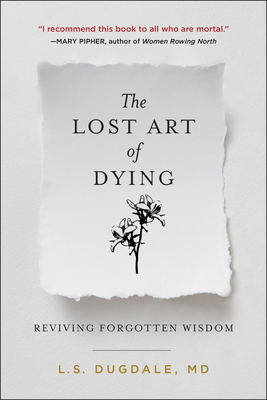What do you think?
Rate this book


272 pages, Hardcover
First published January 1, 2020
I strongly recommend this book to any readers who knows someone who has died or who expects to die themselves one day.
Historically humans were exposed to (if not surrounded by) the dead. Death was a normal state. The concept of ars moriendi - “The art of death” - was a familiar volume in medieval times. The art of a “good death,” argues author/physician Lydia Dugdale, has been forgotten in the twenty-first century, but it must be resurrected.
It appears that Dugdale wrote this most timely little volume to desensitize people to death and dying. Make no mistake: L.S. Dugdale is as fine a writer as I have run across in a long time. She makes her points in clear, cogent, concise, and convincing fashion. She’s easy to read, and easier still to follow.
Here are some highlights:
“Dying well means grappling with our existential questions and not avoiding them. The ars moriendi attends to the metaphysical as well as the physical.”< (p.150)
"Some religions make a point of encouraging reflection on human brokenness.” (p.130)
Health care professionals are “No longer considered ‘healers,’ we are called ‘providers’ - the purveyors of death-delaying goods to our consumer patients.” (p.149)
From the chapter called “Ritual,” the author poses the question of who should care for the physical remains of our dead:
“I wish to return to the theme of caring for the bodies of the dead. The question is this: whether or not we embalm, is it not curious that we willingly pass off responsibility for intimate rituals associated with attending to dead bodies? Shouldn’t we be the ones to care for the bodies of our loved ones?” (p.161)
She advocates patience and hopefulness as keys to a good life and thus a good death:
“Impatience, the ars moriendi taught, can be moderated through the lifelong cultivation of the virtue of patience. The transformation does not happen instantly when a person wills it. Patience must be practiced. Like any habit, you have to commit to exercising patience over and over again.
So too with the other virtues that the ars moriendi commended the dying to cultivate. The tendency to despair as death approaches can be remedied through a lifetime of exercising hopefulness.” (p.206)
Finally, she shares an allegorical tale about death:
“The Legend of the Merchant of Baghdad:
“A merchant sends his servant down to the market. The servant quickly returns. He is agitated and frightened. He says to his master, “Down at the marketplace I was jostled by a woman in the crowd, and when I turned around I saw that it was Death that jostled me. She looked at me and made a threatening gesture. Master, please lend me your horse, for I must hasten away to avoid her. I will ride to Samarra and there I will hide, and Death will not find me.
The merchant agrees, lends his horse, and the servant wastes no time in galloping off. Later that day, the merchant himself heads down to the market and finds Death standing in the crowd. He asks her why she made a threatening gesture at his servant that morning.
Death replies, “That was not a threatening gesture. It was only a start of surprise. I was astonished to see him in Baghdad, for I have an appointment with him tonight in Samarra.”
This story reminds us that none of us escapes our appointment with death. The solution is neither to flee it or to seek it out. Rather, we must each prepare for Samarra. Death is part of life. The art of dying well must necessarily be wrapped up in the art of living.” (p.207-8).
Here’s a little closing trivia that was too good to omit:
There is a “frailty index” that hospitals use to measure the elderly.
Don’t expect too much from CPR; only about ten to twenty percent of resuscitated patients survive to leave the hospital (p. 195-6).
Every reader will benefit from reading this little book.
My rating: 7.75/10, finished 1/28/22 (3616).